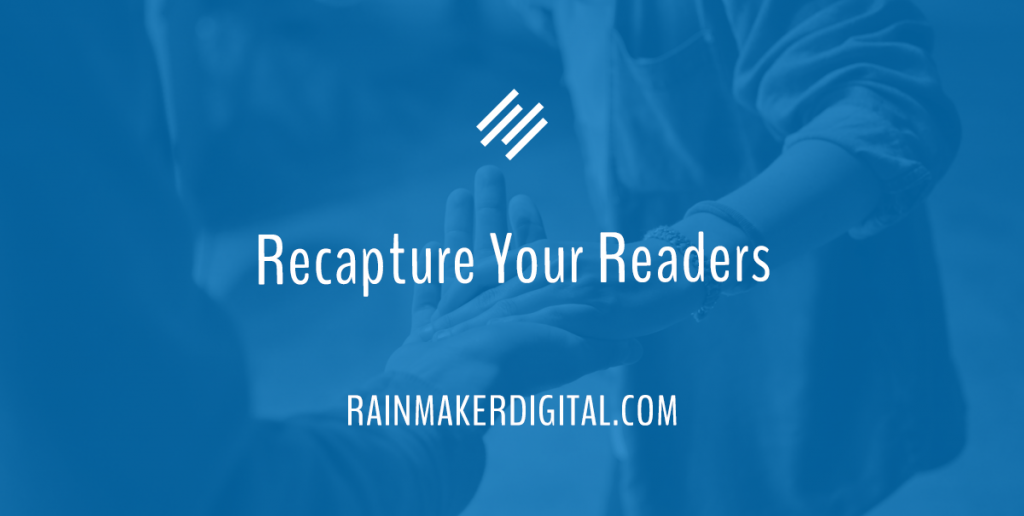
Has your audience stopped paying attention to you?
Content marketing is designed to prevent this, but there are a number of reasons why people might still stop listening. Audience preferences change — maybe they started doing something else. Your segmentation might be wrong. Your content might not be good enough. Or maybe you’re not giving them enough payoff.
Whatever the reason, people stop reading your content. And that’s a problem you need to fix.
Re-engage your readers with an email campaign.
Building Your Email Sequence
Your subscriber list is the place to start. It’s the first area where you’ll see drop-off and the easiest area to get back. Go through your email list and figure out which customers haven’t opened your emails in a while.
A good rule of thumb is if they haven’t opened an email in 60 days, it might be time to reach out and see if they’re still interested.
There are four different types of emails you should send, and you should send them in order. You don’t have to send only four emails — but you should stick to these four types in this order. (Full disclosure: I took this list from ActiveCampaign and fleshed it out. It’s so good I can’t improve on it.)
Reminder
Your first outreach should just be a reminder. These people in your audience signed up for your emails in the first place; there’s a reason for that. Remind them of your good content. This might be a good time to bring up some of your greatest hits — the most popular blogs, the best of your courses and ebooks.
You can capitalize on new features here too. If they haven’t been paying attention, they might not know what you’ve been adding to your business. You can advertise your new features in a “look what we added” email.
Review
It might be that you’re sending emails to the wrong segment. Or you may be sending emails too often. Offer your readers a chance to change their email preferences. If they signed up for too many updates from you, this is a great time to let them adjust that so they only get what they’re interested in.
51% of unsubscribes happen because emails come too often. That’s just official unsubscribes — plenty of your customers may just be ignoring you because they hear from you too much. Remind them why they were interested in your content in the first place, then offer them a way to adjust how much of it they’re getting.
Receive
Not getting any response? It’s time to break out the big guns.
This is where you offer them something to come back. Maybe it’s a free ebook or access to a premium course. Or it could be a discount on a product or service you offer. Whatever it is, offer something tangible and substantial.
Make sure your offer is clear in the subject line of the email so it gets opened. Don’t lean too hard on “free” — that can get your email flagged by spam filters, especially if they haven’t been opening your emails much already. Google and other webmail services will stop delivering your emails sometimes if your customers don’t open them. See our article on spam filters to learn more.
Your headline will be crucial here. Showcase the benefit up front; make sure they open it.
Regret
This is your last-ditch offer. You’re leaning on emotion here. “We’ll miss you” or “Sorry we’re not what you were looking for” are sentiments that can make a difference.
You want to give them a sense of belonging to a community. Your emails here have to show them that their lack of engagement means they’re not a part of a group they want to be a part of.
Offer them the chance to unsubscribe here, and make it big. Articulate the benefits and then make it easy for them to opt out. It might sound counterintuitive, but faced with the reality of the fact that you care, people might re-engage when you make it clear what they’re doing. Make the choice binary. You don’t want people on your mailing list that don’t want to listen. They don’t want to be there either.
These are the four types of emails you should send. You should at least send four emails — one for each. Send more if you like, but four is the minimum.
How Long?
There’s no set number of emails to send in the re-engagement campaign, but generally you should go between four to six emails (depending on how long your readers have been lapsed.)
How long should your message be? It depends. Marketer Dean Jackson has a nine-word email that gets results for him. Some people go a lot higher than that. It depends on your audience; test and adjust based on them.
How long should your audience be lapsed before you engage? Again, it depends. Jackson recommends 90 days on his email series. 30 to 60 days is the earlier threshold if you want to re-engage in a shorter time period.
Recapture Your Readers
Your readers may be dropping off, and you need to make sure they don’t. Use the power of a re-engagement email campaign to capture them again. And if you need a little assistance with your email strategy, feel free to reach out. We’re here to help.
Best Regards,
David Brandon
Copywriter
Rainmaker Digital Services